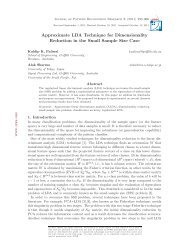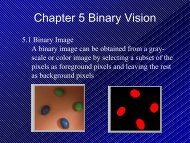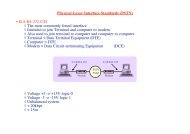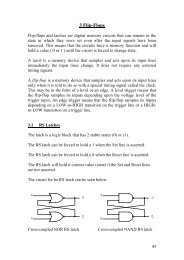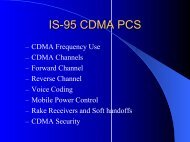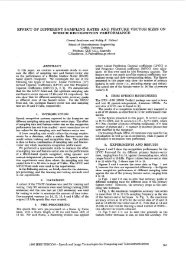"Personal Communication System"...
"Personal Communication System"...
"Personal Communication System"...
- No tags were found...
Create successful ePaper yourself
Turn your PDF publications into a flip-book with our unique Google optimized e-Paper software.
• Frequency Range– The broadband PCS band consists of 120 MHz in the1900-MHz region.– The term broadband here is relative. It refers tobandwidth sufficient for voice communication anddistinguishes this service from such narrowband aspaging.– See table 11.1 for the PCS band plan [1].• There are six frequency allocations, so up to six licenses can beawarded in any given area.• There are three 30-MHz and three 10-MHz allocations.• The reverse channel or uplink (mobile to base) is 80 MHzabove the forward channel or downlink (base to mobile)frequency.• Reverse and forward channel allocations are separated by a 20-MHz band, from 1910 to 1930 MHz, which is allocated forunlicensed services like short-range voice communication.
Broadband PCS Band Plan [1]
• Coverage– The coverage for any PCS is much lessuniversal than it is for AMPS cell phones.• Rate Structure– One of the arguments for PCS is that theyshould be less expensive than analog cellularradio.– The utilization of spectrum space is moreefficient, for example.
• Forward channel:– The SYNC (synchronizing) bits have the same functionas for the voice channels, allowing the mobile receiverto lock on the beginning of the transmission.– The SCF (shared channel feedback) bits performseveral functions. They provide acknowledgement ofmessages from mobiles and inform the mobiles of thestatus of the reverse control channel.– CSFP (code superframe phase) bits identify the locationof this time slot in a large frame that extends over 16TDMA frames or 32 blocks of control-channel data,representing a time period of 640 ms.– Table 11.2 summarizes the logical channels, and a briefdescription of each channel [1].
GSM• GSM is the system used in Europe and mostof Asia for both cellular and PCS bands.• GSM is another TDMA system but thedetails are different.• GSM also has some unique features thatmake it arguably more sophisticated andversatile than IS-136.• It is not compatible with existing IS-136cell site equipment.
GSM RF Channels and Time Slots– GSM channels are 200 kHz wide (compared with 30kHz for IS-136 TDMA).– The total bit rate for an RF channel is 270.833 kb/s; themodulation is a variant of FSK called GMSK (Gaussianminimum shift keying) using a frequency deviation of67.708 kHz each way from the carrier frequency.– Voice channels are called traffic channels (TCH) inGSM. One RF channel is shared by eight voicetransmissions using TDMA.– In terms of spectral efficiency, GSM works out to 25kHz per voice channel, compared to about 30 kHz forAMPS and about 10 kHz for TDMA.– A GSM phone should have longer battery life than aphone using either AMPS or TDMA.
– Figure 11.2 shows the structure of an RFchannel and its division into time slots (calledbursts in GSM) [1].– Control information in GSM is on two logicalchannels called the broadcast channel (BCCH)and the paging channel (PCH).
• The broadcast information is transmittedfirst, followed by paging information. SeeFigure 11.3 for an illustration [1].
Voice transmission– Each voice transmission is located at 13 kb/sand is allocated one time slot per frame.– A frame lasts 4.615 ms so each time slot isapproximately 577 µs in duration. To allowtime for transmitters to turn on and off, theuseful portion of the time slot is 542.8 µs,which allows time for 147 bits. Figure 11.4shows the structure of a voice channel [1].
Frequency Hopping in GSM– When multipath fading is a problem, the GSM systemallows for frequency hopping, a type of spreadspectrumcommunication.– The system can hope only among the frequencies thatare assigned to the cell, so there will be only a fewhopping possibilities (on the order of three frequencies)– Thus GSM is not really a true spread-spectrum system,but rather a TDM/FDM system with some spreadspectrumcapability added on. This feature is unique toGSM; IS-136 TDMA has nothing like it.
Subscriber ID Module– The subscriber ID module (SIM) is unique to theGSM system. It is a smart card with eight kilobytes ofmemory that can be plugged into any GSM phone.– The SIM contains all subscriber information includingtelephone number (called the International MobileSubscriber Identification (IMIS) in GSM), a list ofnetworks and countries where the user is entitled toservice, and other user-specified information such asmemories and speed dial numbers.– The SIM also offers some protection against fraudulentuse. A GSM phone is useless without a SIM; if the userremoves the card when leaving the phone in a car, forexample, the phone cannot be used unless the thief hasa valid SIM.
GSM Privacy and Security• The GSM SIM is only a part of the effortthat has gone into securing this system.• The security in GSM is better than in IS-136 and much better than in analog AMPS.
i-mode mobile communication [2]– i-mode by NTT docomo in 2/1999– EZweb by KDDI/Tsuka in 4/1999– J-SKY by J-Phone in 10/1999
• Gateway [2]
• i-mode packetscommunication [2]
• Web page view [2]
• Graphics [2]
• WAP & HTML [2]
References• [1] R. Blake, "wireless <strong>Communication</strong>Technology", Delmar, Thomsn Learning,2001.• [2] K.Kojima, "i-Mpde", Natsume, Japan,2002



